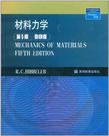材料力学
出版时间:2004-2 出版社:高等教育出版社 作者:希伯勒
Tag标签:无
前言
本书由R.C.Hibbeler教授编著,1991年出版第1版,2003年出版第5版。自1974年以来,R.C.Hibbeler教授还编著有Engineer ingMechaniCS,Structual hnalysi S与Mechanics for Engineers等9种教材。R.C.Hibbeler教授在25程力学教育方面,作出了很大贡献,他编著的教材,在美国得到广泛采用,在国际同行中也得到普遍好评。本书重视基本概念、基本理论-9基本方法的讲述,思路清晰,层次分明,既简明易懂,又论述严谨。全书选编了211个例题,通过这些例题,许多解题的方法-9技巧,得到了具体而生动地揭示,提高了学生分析问题的能力。本书在许多节的后面,均安排了“重点”(Important Point s)-9“分析方法”(Procedure for AnalysiS),这些提示对主要概念、理论-9方法进行了高度概括,论述精要,对学生学习有很大的帮助。本书在联系X-程实际方面,非常突出。书中编选的例题-9习题(多达1600个),大部分甚至绝大部分来自25程实际或具有工程背景。更新颖的是,在本书每一章的开始-9每一节的页旁,均附有X-程图片,用以说明该章或该节内容的工程背景-9应用。材料力学作为工程力学的一个重要分支,培养学生的工程意识与分析解决工程实际问题的能力,是十分重要的。本书第1-9第2章分别讲述应力-9应变的概念。
内容概要
本书重视基本概念、基本理论与基本方法的讲述,思路清晰,层次分明,既简明易懂,又论述严谨。全书选编了211个例题,通过这些例题,许多解题的方法与技巧,得到了具体而生动地揭示,提高了学生分析问题的能力。许多节的后面,均安排了"重点"与"分析方法",这些提示对主要概念、理论与方法进行了高度概括,论述精要,对学生学习有很大的帮助。本书第1与第2章分别讲述应力与应变的概念。第3章介绍材料的力学性能。第4,5与第6各章分别论述构件在轴向加载、扭转与弯曲时的应力与变形,涵盖线弹性与非弹性,涉及应力集中与残余应力。第7章研究梁横向剪切时的应力,包括薄壁梁的剪流与剪心。第8章讨论组合载荷问题。第9与第1O章分别讲述应力与应变的变换,在第10章还介绍了失效理论。第11章介绍梁与轴的设计,第12章研究梁与轴的位移。第13章讲述柱的稳定性。第14章讲述能量法,包括虚功原理、单位载荷法、卡氏定理与冲击载荷问题。关于截面的几何性质则集中在附录A给出。本书是一本优秀教材,其内容与我国当前高等工科院校材料力学的教学要求也相当接近,本书既可作为进行双语教学材料力学课程的基本教材,也可作为学习材料力学课程的主要参考书。
作者简介
作者:(美国)希伯勒(Hibbeler.R.C)
书籍目录
PREFACE
1 STRESS
1.1 introduction
1.2 equilibrium of a deformable Body
1.3 stress
1.4 Average Normal stress in an Axially loaded bar
1.5 Average shear stress
1.6 Allowable stress
2 STRAIN
2.1 deformation
2.2 strain
3 mechanical properties of materials
3.1 The tension and compression test
3.2 The stress-Strain Diagram
3.3 stress-strain behavior of ductile and brittle materials
3.4 Hooke’s law
3.5 strain energy
3.6 Poisson’s ratio
3.7 the shear stress-strain diagram
3.8 failure of materials due to creep and fatigue
4 axial load
4.1 Saint-Venant’s principle
4.2 Elastic deformation of an axially loaded member
4.3 principle of superposition
4.4 statically indeterminate axially loaded member
4.5 the force method of analysis for axially loaded members
4.6 thermal stress
4.7 stress concentrations
4.8 inelastic axial deformation
4.9 residual stress
5 torsion
5.1 Torsional deformation of a circular shaft
5.2 the torsion formula
5.3 power transmission
5.4 angle of twist
5.5 statically indeterminate torque-loaded members
5.6 solid noncircular shafts
5.7 thin-walled tubes having closed cross section
5.8 stress concentration
5.9 inelastic torsion
5.10 residual stress
6 bending
6.1 shear and moment diagrams
6.2 graphical method for constructing shear and moment
diagrams
6.3 bending deformation of a straight member
7 TRANSVERSE SHEAR
7.1 Shear in Straight Members
7.2 The Shear Formula
7.3 Shear Stresses in Beams
7.4 Shear Flow in Built-up Members
7.5 Shear Flow in Thin-Walled Members
7.6 Shear Center
8 COMBINED LOADINGS
8.1 Thin-Walled Vessels
8.2 State of Stress Caused by Combined Loadings
9 STRESS TRANSFORMATION
9.1 Plane-Stress Transformation
9.2 General Equations of Plane-Stress Transformation
9.3 Principal Stresses and Maximum In-Plane Shear Stress
9.4 Mohr’s Circle——Plane Stress
9.5 Stress in Shafts Due to Axial Load and Torsion
9.6 Stress Variations Throughout a Prismatic Beam
9.7 Absolute Maximum Shear Stress
10 STRAIN TRANSFORMATION
10.1 Plane Strain
10.2 General Equations of Plane-Strain Transformation
10.3 Mohr's Circle——Plane Strain
10.4 Absolute Maximum Shear Strain
10.5 Strain Rosettes
10.6 Material-Property RelatiOnshiDs5
10.7 Theories of Failure
11 DESIGN OF BEAMS AND SHAFTS
11.1 Basis for Beam Design
11.2 Prismatic Beam Design
11.3 Fully Stressed Beams
11.4 Shaft Design
12 DEFLECTIONS OF BEAMMS AND SHAFIS
12.1 The Elastic Curve
12.2 Slope and Displacement by Integration
12.3 Discontinuity Functions
12.4 Slope and Displacement by the Moment-Area Method
12.5 Method of Superposition
12.6 Statically Indeterminate Beams and Shafts
12.7 Statically Indeterminate Beams and Shafts-Method of
Integration
12.8 Statically Indeterminate Beams and Shafts Moment-Area
Method
12.9 Statically Indeterminate Beams and Shaft-Method of
Superposition
13 BUCKLING OF COLUMNS
13.1 critical Load
13.2 Ideal Column with Pin Supports
13.3 Columns Having Various Types of Supports
13.4 The Secant Formula
13.5 Inelastic Buckling
13.6 Design of Columns for Concentric Loading
13.7 Design of Columns for Eccentric Loading
14 ENERGY METHODS
A GEOMETRIC PROPERTIES OF AN AREA
B GEOMETRICAL PROPERTIES OF STRUCTURAL SHAPES
C SLOPES AND DEFLECTIONS OF BEAMS
D REVIEW FOR THE FUNDAMENTALS OF ENGINEERING EXAM
ANSWERS
INDEX
章节摘录
插图:
编辑推荐
《材料力学(第5版影印版)》是一本优秀教材,其内容与我国当前高等工科院校材料力学的教学要求也相当接近,《材料力学(第5版影印版)》既可作为进行双语教学材料力学课程的基本教材,也可作为学习材料力学课程的主要参考书。
图书封面
图书标签Tags
无
评论、评分、阅读与下载
用户评论 (总计10条)
- 国外的教材编的很有特的,这本希伯勒的《材料力学》作为搞工科的人很值得一读。
- 很清楚,字太密了,不过英文影印版书都这样
- 很厚的书,国外教材借鉴学习下。
- 这本书帮单位采购的,说是必备的工具书,所以只能点评这些。可惜是英文版的,没用了,也不晓得能不能退掉,时间太久了,要有人需要这书的话,全新书原价5折出手,联系QQ27010338,谢谢!
- 知识的安排,解读很有特点
- 把它作为参考,看对工作能否带来帮助
- 书的封底折了角,美中不足
- 比较基础,英文版,适合英文好的同学看看
- 英文版的,留着慢慢看
- 虽然书籍有些年份了,但是专业价值还是很好。
